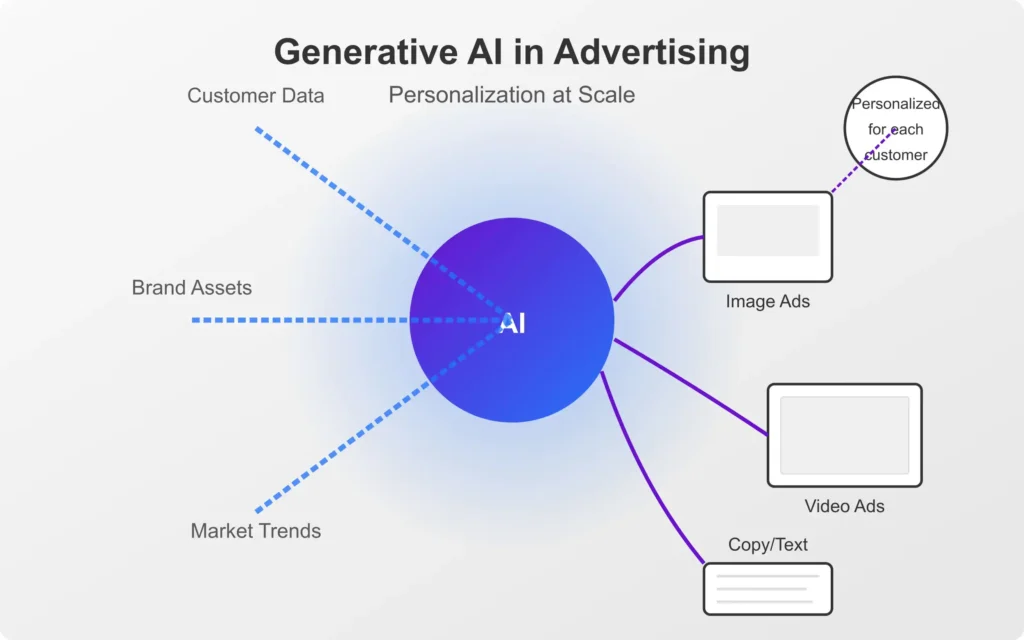
The advertising landscape is undergoing a dramatic transformation as generative AI technologies become more sophisticated and widely adopted. What began as experimental tools in 2024 has evolved into essential components of modern marketing strategies, with 2025 marking a pivotal year for AI-powered advertising.
The Personalization Revolution
Modern generative AI systems can produce entirely unique creative assets for each viewer, including:
- Customized copywriting that resonates with specific customer segments
- Visual elements that reflect individual preferences and interests
- Video content dynamically assembled based on viewer characteristics
- Product recommendations that genuinely align with consumer needs
Efficiency at Scale
Perhaps most impressive is how generative AI enables this level of personalization at scale. What would have required armies of copywriters, designers, and video editors can now be accomplished through sophisticated AI systems that generate thousands of variations in minutes.
This efficiency translates directly to marketing ROI. Early adopters report significant improvements in key metrics:
- Higher click-through rates on personalized creative
- Increased conversion rates from tailored messaging
- Lower cost-per-acquisition through more efficient ad spending
- Greater customer engagement with dynamically generated content
Real-World Applications
Forward-thinking brands are already implementing generative AI across various advertising channels:
Social Media Advertising: AI tools automatically generate platform-specific creative that resonates with different audience segments, adjusting tone, imagery, and calls-to-action based on user behavior.
Programmatic Display: Dynamic creative optimization powered by generative AI creates unique banner ads tailored to individual users, dramatically improving engagement compared to static alternatives.
Email Marketing: Beyond simple personalization tokens, generative AI now crafts entire email campaigns with customized content blocks, offers, and visuals based on recipient data.
Video Advertising: Perhaps most impressively, AI systems can now generate customized video ads by assembling and modifying footage, voiceovers, and text elements to create personalized viewing experiences.
Challenges and Considerations
Despite its promise, generative AI in advertising isn’t without challenges. Marketers must navigate important considerations:
Brand Consistency: While personalization is valuable, maintaining consistent brand voice and visual identity remains crucial. Leading AI systems now include brand guidelines as parameters to ensure generated content remains on-brand.
Privacy Concerns: As personalization becomes more sophisticated, consumers are increasingly conscious of how their data is used. Transparent data practices and ethical AI usage will be essential.
Quality Control: Even advanced AI requires human oversight. The most successful implementations maintain a balance between automation and human creative direction.
The Future of Creative Work
Contrary to early fears, generative AI isn’t replacing creative professionals—it’s transforming their roles. The most effective advertising teams now pair human creativity with AI capabilities:
- Strategists focus on higher-level campaign planning
- Creatives direct and refine AI outputs rather than producing every asset
- Data analysts gain importance in training and optimizing AI systems
- New roles emerge at the intersection of creative direction and AI management
Looking Ahead
As we move through 2025, generative AI will continue advancing in sophistication and accessibility. The competitive advantage currently enjoyed by early adopters will become table stakes for effective advertising. Brands that embrace these technologies—while maintaining human oversight and ethical practices—will likely see significant advantages in engagement, conversion, and customer loyalty.
For marketers, the message is clear: generative AI isn’t just another tool—it’s reshaping what’s possible in advertising personalization, efficiency, and creative execution.

